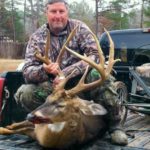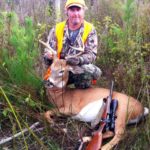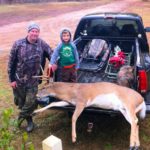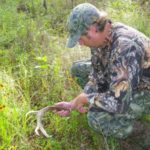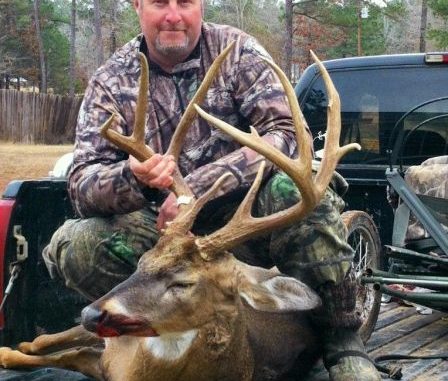
Jackson Bienville Wildlife Management Area is a popular meat-haul for many hunters, but it’s also home to some brute bucks. Learn how this regular targets trophy public-land deer.
There are several types of deer hunters who fit into one class or other. First, there’s the meat hunter, who is only interested in putting venison in the freezer, and once he gets his doe or yearling buck he’s done for the year.
Then there is the average deer hunter who does the minimum to prepare for deer season. He might get a deer, and he might not. But in either case he’s OK because he just enjoys being out there in the woods in winter — provided it’s not too cold, rainy or windy.
A third class of deer hunter is the fellow who pays a hefty sum to be a member of a hunting club where big bucks hang out. Because of his investment, both monetarily and time-wise, he’s serious about getting a good return on his investment in the form of having a chance at a wall-hanger buck.
Finally, there’s the class of hunter like 42-year-old Brad Doughty, and there aren’t too many like him.
Doughty only hunts big bucks, and he only goes after them on public land.
And one of Doughty’s favorite public areas to hunt is the 30,000-acre Jackson Bienville Wildlife Management Area south of Ruston.
Jackson Bienville is the target of an annual pilgrimage of hunters from all over the state. Most of those hunters have one goal in mind: They want to shoot a deer — any legal deer. And because of the high population of deer on this area, many of see their wish fulfilled.
While these hunters are roaming the Jackson Bienville woods, Doughty, who resides in Downsville, is hunting on either Union or D’Arbonne wildlife management areas. He isn’t thinking bucks early on; he’s looking for freezer meat.
Come late December, however, Doughty takes on the demeanor of a different hunter. He has his venison; now it’s time to concentrate on bagging a trophy buck, and his eye is on Jackson Bienville, his favorite public land honey hole for big bucks.
“A dozen or so years ago, a friend shot a really nice buck on Jackson Bienville, so I went down to check it out,” Doughty said. “After talking with the biologist overseeing the area and making a tour, I came away impressed. With all the cover and food sources available, there was no doubt in my mind this area held some big deer, so I did some scouting and started hunting there, concentrating on big bucks only.”
At first blush, you might assume that to concentrate only on trophy bucks on an area that sees tremendously heavy hunting pressure makes no sense. To Doughty, however, this presents absolutely no problem.
“Most of the hunters who are there early on are not really interested in getting a trophy buck; they’re after meat,” Doughty said. “Even though there is the chance that someone will get a good buck during early season, that’s not likely because the big ones are way back in the thickets, moving and feeding only at night for one main reason: The rut has not kicked in, so they have no reason to be up and looking for does.”
By mid-December, however, the majority of the meat hunters have left, and it’s time for Doughty and a handful of other hunters, to set their sights on the rut, which kicks in on Jackson Bienville around the second week in December and lasts until season ends in early January. It’s during this brief window — when the tantalizing scent of a doe in estrous reaches his nostrils — that a mature buck that has been lolly-gagging back in the thickets lets down his guard.
“I can tell when the rut is beginning to kick in by scouting the woods trails and old roads,” Doughty said. “Scrapes that had been cleaned out regularly are now covered with leaves because they’re no longer needed: When I see this, I know the buck that made this scrape is already focusing on and chasing receptive does.
“Another tip to let me know the rut has kicked in is to find tracks of running deer in pursuit of does. When I find this, I arrange my schedule so I can be in the Jackson Bienville woods every chance I get.”
But how does Doughty know where to concentrate his scouting on this massive public area?
“I visit regularly with the wildlife biologists who work the area, finding out all I can on what deer have been taken, how big they were and what areas most of them came from,” he said. “Also, I’ll stop and talk with members of logging crews to see what they’ve seen or observed while they’re harvesting timber.
“It’s interesting that deer aren’t too disturbed by the loggers at work, and out of curiosity will step out in the road to see what’s going on. Loggers will usually freely share information about when and where they may have seen a good buck, and this helps me zero in on areas to scout.”
Doughty also said his dad taught him something years ago that has helped him be successful with some of his big bucks.
“He said if you want to have a chance at big bucks, hunt the thickets because this is where they hang out,” Doughty said. “I took a gamble and started hunting some thick, grown-up clear-cuts where timber had been harvested a couple of years earlier. The first morning I hunted such an area, I climbed high in a tree so I could see down into the thick stuff and saw seven different deer — smaller bucks and does.
“There are times when I hunt from a short ladder or a ground blind when a particular thicket has good visibility at ground level, but for the most part I’m way up in a tree so I have an up-above view of the trails that can’t be seen from the ground.”
He’s been doing this so long it’s now just second nature.
“Since I started hunting thickets, I’ve sort of fine tuned when the rut starts, and I’ll be set up close to a thicket where I’ve found good buck sign,” he said.
Doughty looks for certain types of setups when deciding where to hang his climbing stand. There are criteria he finds that helps him be in the best possible location when a good buck presents himself.
“To me, the ideal place to hang your stand is overlooking what I call a ‘corner,’” he said. “If you have a thicket that connects with a clear-cut or find a spot where two different timber types meet, that’s a ‘corner.’
“These areas are important because, although a doe may run out into the clearing, big bucks tend to try and prevent this by cutting these corners rather than come on out into a clearing following a doe. Mature bucks like corners because it provides the shortest distance for him to chase a doe.”
Because of the necessity to be able to see into the thick stuff, Doughty affixes his climbing stand to a sturdy pine long before daylight and scoots up 25 to 35 feet high.
“You can be sure I use my safety harness anytime I’m climbing,” he said. “I climb this high because you can actually see trails and openings not visible from the ground. It also gives me a better chance for my scent not being picked up by a deer.”
Utilizing the techniques and information he has learned, Doughty bagged two impressive bucks on Jackson Bienville last season, a 230-pound 8-point and an 11-point that green scored 150 3/8 inches —both in mid- to late December as the rut was kicking in.
“People may not realize it, but there are some really big deer in those thickets,” he said. “There are lots in the 170- to 200-pound range, and some of these bucks probably die of old age, never seeing a human. This is why I like to go after them in those thick hideouts.”
